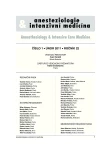The Czech Anaesthesia Day 2010 – a national prospective observational one-day prevalence study of the current anaesthesia practice in the Czech Republic
Authors:
Černý Vladimír 1,2; Adamus Milan 3; Cvachovec Karel 4; Ševčík Pavel 5; Herold Ivan 6*
Authors‘ workplace:
Dalhousie University, Dept. of Anesthesia, Halifax, Nova Scotia, Canada
1; Klinika anesteziologie, resuscitace a intenzivní medicíny, Univerzita Karlova v Praze, Lékařská fakulta v Hradci Králové, Fakultní nemocnice Hradec Králové
2; Klinika anesteziologie a resuscitace, Lékařská fakulta Univerzity Palackého v Olomouci, Fakultní nemocnice Olomouc
3; Klinika anesteziologie a resuscitace, Univerzita Karlova v Praze, 2. lékařská fakulta a IPVZ, Fakultní nemocnice Motol, Praha
4; Klinika anesteziologie, resuscitace a intenzivní medicíny, Lékařská fakulta Masarykovy univerzity Brno, Fakultní nemocnice Brno
5; Anesteziologicko-resuscitační oddělení, Oblastní nemocnice Mladá Boleslav, a. s., Nemocnice Středočeského kraje
6
Published in:
Anest. intenziv. Med., 22, 2011, č. 1, s. 5-12
Category:
Anaesthesiology - Original Paper
Overview
Objective:
The aim of this study was to take a snapshot of the anaesthetic modes and techniques used in the Czech Republic.
Design:
A prospective, one-day, questionnaire study.
Setting:
All units delivering anaesthetic services registered prior to the commencement of the study.
Materials and methods:
The study enrolled all patients in the registered units whose care by the anaesthetist commenced between 07:00 and 24:00 on 1st June 2010. Each patient’s data were entered on-line via an internet based form. The studied parameters included basic demographic data, ASA class, procedure, type of anaesthesia, airway management, anaesthetic agents, neuro-muscular blocking drugs (NMBDs) and neuro-muscular blockade antagonism, infusion therapy and post-anaesthesia care location.
Results:
Data for 2520 patients were collected, of whom 2514 were analyzed (1176 men, 1338 women). Total 2306 (91.7 %) procedures were performed as in-patient and 208 (8.3 %) as day-case procedures. General anaesthesia (GA) was performed in 82.6 % and 79.3 % of in-patients and day-patients respectively. A total of 92 % of all procedures performed under GA were carried out as in-patient and 8 % as day-case procedures. Airway management for GA: tracheal intubation (59.8 %), LMA (18.8 %), other devices (11.2 %) and device-free (10.1 %). The most common induction agent was propofol (71.3 %) and opioids (76.4 %), the most frequently used NMBDs were non-depolarizing NMBDs (36.4 %) and suxamethonimum (18.5 %). Maintenance agents: opioids (66 %), isoflurane (43.8 %), sevoflurane (38.5 %) and nitrous oxide (58.3 %). The most commonly used NMBDs were atracurium (43.1 %) and rocuronium (24.2 %). The most common intravenous fluids were crystalloids (85.4 %). Following GA 41 % patients went to the ward, 25.9 % to the post-anaesthesia care unit (recovery) and 23.3 % to HDU/ICU.
Conclusion:
Anaesthetic care is most frequently given to ASA I – II patients in the Czech Republic. GA is the most common technique. The most frequently used agents include propofol, opioids, isoflurane, sevoflurane and atracurium / rocuronium. Post-anaesthesia care is usually provided on post-anaesthesia care units, HDU/ICUs or on standard wards. In comparison with other countries there is a low proportion of procedures performed without subsequent hospitalisation of the patient.
Keywords:
general anaesthesia – regional anaesthesia – questionnaire study
Sources
1. www.uzis.cz.
2. www.csarim.cz.
3. Černý, V., Cvachovec, K., Ševčík, P. et al. Doba úvodu a zotavení z celkové anestezie – prospektivní studie. Anest. intenziv. Med., 20, 2009, č. 5, s. 236–240.
4. Kinsella, S. M., Walton, B., Sashidharan, R., Draycott, T. Category-1 caesarean section: a survey of anaesthetic and peri-operative management in the UK. Anaesthesia, 2010, 65, 4, p. 362–368.
5. Naguib, M., Kopman, A. F., Lien, C. A. et al. A survey of current management of neuromuscular block in the United States and Europe. Anesthesia and analgesia, 2010, 111, 1, p. 110–119.
6. Payne, K., Moore, E. W., Elliott, R. A. et al. Anaesthesia for day case surgery: a survey of adult clinical practice in the UK. European journal of anaesthesiology, 2003, 20, 4, p. 311–324.
7. Pasternak, J. J., Lanier, W. L. Is nitrous oxide use appropriate in neurosurgical and neurologically at-risk patients? Current opinion in anaesthesiology, 2010, 23, 5, p. 544–550.
8. Sanders, R. D., Weimann, J., Maze, M. Biologic effects of nitrous oxide: a mechanistic and toxicologic review. [Internet]. Anesthesiology, 2008, 109, 4, p. 707–722.
9. Erickson, T. B., Kirkpatrick, D. H., DeFrancesco, M. S., Lawrence, H. C. Executive summary of the American College of Obstetricians and Gynecologists Presidential Task Force on Patient Safety in the Office Setting: reinvigorating safety in office-based gynecologic surgery. Obstetrics and gynecology, 2010, 115, 1, p. 147–151.
10. Bouaziz, H., Bondàr, A., Jochum, D. et al. Regional anaesthesia practice for total knee arthroplasty: French national survey – 2008. Annales françaises d’anesthèsie et de rèanimation, 2010, 29, 6, p. 440–451.
11. Hussain, R., Matare, T., Zambarakji, H. National survey of day-case vitreoretinal surgery in the United Kingdom. European journal of ophthalmology, 2010, Available from: http://www.ncbi.nlm.nih.gov/pubmed/20623468.
12. www.asahq.org.
13. Raeder, J. Clinical Ambulatory Anaesthesia. Cambridge University Press: New York, 2010, ISBN-13: 9780521737814.
Labels
Anaesthesiology, Resuscitation and Inten Intensive Care MedicineArticle was published in
Anaesthesiology and Intensive Care Medicine

2011 Issue 1
Most read in this issue
- Classification and diagnosis of kidney injury – are they still imperfect?
- The administration of packed red blood cells and its influence on electrolyte and acid-base balance disturbances in vivo
- Evolution of Anaesthesiology and Resuscitation at Prague’s Medical Faculties
- New biomarkers in the diagnosis of renal dysfunction
